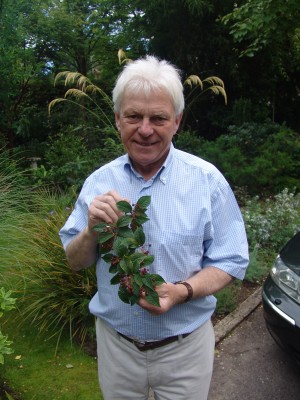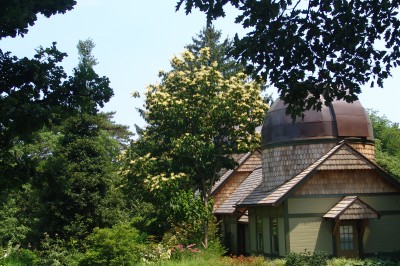Poliothyrsis sinensis
Last week, world renowned plantsman Roy Lancaster lectured at our 12th annual Woody Plant Conference. On the Thursday before the conference I had the opportunity to give Roy and some of the other speakers a tour of the Arboretum. As we headed back to the Arboretum offices Roy spotted a specimen of Poliothyrsis sinensis growing next to the Cunningham House. He stated that this was the most impressive tree he had seen that day (we had also visited the Morris Arboretum in the morning).
In 1993, we received a few seedlings of Poliothyrsis sinensis from J. C. Raulston at the North Carolina State University Arboretum (now the J. C. Raulston Arboretum). For several years they were grown on in our growing area. When they were mature enough to add to the Arboretum’s collections we added one to the Entrance Garden; another one is planted near College Avenue next to the Arboretum’s parking lot, and a few more are between the site of the future Education Center and Greenhouse and Mertz Dormitory.
Today, all the trees are about thirty feet tall. The trees are now covered with pyramidal clusters of white flowers. Quick observation, several people have thought it was the Japanese tree lilac, Syringa reticulata, but Poliothyrsis blooms several weeks later.
I feel this tree holds great potential as a medium-sized, summer-flowering tree. It seems to be tolerant of difficult sites, and perhaps would make a tough street tree in urban situations.








Jim
Posted at 08:21h, 21 JulyI do not grow Syringa reticulata of it has a smell akin to privit, another plant whose smell makes me nauseous. Does Poliothyrsis have any “fragrance”? What is the hardiness?
Thank you,
Jim
Andrew Bunting
Posted at 08:56h, 21 JulyPoliothyrsis has not real fragrance. I would say it is hardy to USDA zone 6B.
Andrew Bunting
Jim
Posted at 23:07h, 28 OctoberI have seen Poliothyrsis at the National Arboretum in Washington, D.C. but not in flower, so I was very appreciative of your article and photos on this rare tree in your Bulletin. I have three saplings I obtained mail order from the East Coast. Two are still in pots but I am trialing one out in the open garden. I noticed that new growth was decidedly reddish on the plants, fading later to green but only after a couple months. Is that a characteristic you’ve noticed with your trees? How many years after planting did your trees flower? Is “pearlbloom tree” the accepted common name for this tree? Thanks!
Andrew Bunting
Posted at 12:49h, 01 NovemberJim,
All the new growth on our 4 Poliothyrsis trees is green and not red. The fall color can be orange and yellow. I would say that after about 7 years we had flowers on our trees. The trees, for us, grow very quickly. I have never heard of a common name for this tree.
Andrew Bunting, Curator
Jim Gersbach
Posted at 02:05h, 25 FebruaryI have grown three Poliothyrsis sinensis I received mail order from Woodlanders in South Carolina, planting one in my back yard and growing two others on in pots. The new leaves emerged decidedly reddish in spring for a few weeks on all three before fading to green. One of the potted plants actually had a few flowers, which was rather surprising, as the one planted out in the garden did not. I didn’t notice any fragrance, although reference books refer to a scent. I have heard the name pearlbloom applied to this tree, a reference to the whitish flowers. I can’t say as the fall color here in western Oregon was much more than greenish yellow.
Andrew Bunting
Posted at 08:57h, 28 FebruaryJim,
Thanks for your comments. We have reasonable yellow fall color. I have not noticed any fragrance. I, too, have seen the common name pearlbloom. Poliothyrsis remains rare in cultivation. I have noticed seedlings popping up near the plant, so this will be something to keep an eye on.
Andrew Bunting, Curator
Eva Monheim
Posted at 13:43h, 11 AprilA year and a half ago I picked some seeds from Jenny Rose Carey’s Poliothrysis sinensis at North View. (Jenny Rose heads up Meadowbrook Farm.) I was at her garden with students for a visit. I planted the seeds in the Temple University’s greenhouse and they are finally getting large enough to put outside – sometime this year. The foliage is a beautiful russet-red. They are tough plants that have been transplanted several times since they were planted back in December 2015. I look forward to their bloom.